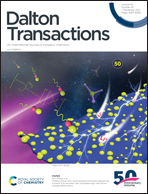Fe-Triazole coordination compound-derived Fe2O3 nanoparticles anchored on Fe-MOF/N-doped carbon nanosheets for efficient electrocatalytic oxygen evolution reaction†
Abstract
Using FeCl3·6H2O and 1,2,4-triazole (Htrz) as starting materials, an Fe coordination compound (CC), [FeCl3(Htrz)3]·H2O, was synthesized at room temperature. Fe-CC can be partially transformed into an Fe metal–organic framework (MOF), [FeCl2(Htrz)], via low-temperature annealing. After sulfurization at 250, 300, and 400 °C, S-doped Fe2O3/N-doped carbon (denoted as NC)/Fe-MOF, FeS2/NC/Fe-MOF, and FeS2/NC were obtained, respectively. S-doped Fe2O3/NC/Fe-MOF shows the best oxygen evolution reaction (OER) catalytic activity in 1 M KOH solution, with overpotentials (η) of 185, 232, and 258 mV required to reach current densities of 10, 30, and 50 mA cm−2, respectively, outperforming commercial RuO2 and most transition-metal oxides reported to date; this high performance is associated with the Fe2O3 nanoparticles (NPs) anchored on the Fe-MOF/NC nanosheets. The Fe-MOF/NC matrix can act as a support to prevent the agglomeration of Fe2O3 NPs. In addition, S-doped Fe2O3/NC/Fe-MOF exhibits long-term OER activity at 20 mA cm−2, which is related to the partial transformation of Fe2O3/Fe-MOF into FeOOH. In addition, density functional theory (DFT) calculations show that the rate-determining step of the OER process at the Fe sites of both Fe2O3 and FeS2 is the formation of Fe*–OH, and the Fe2O3 sites display a lower Gibbs free energy (ΔGmax) of 1.674 eV and a smaller η value of ∼0.444 V. Bader charge, differential charge density mapping, and density of states (DOS) analysis all reveal more charge accumulation at the Fe sites of FeS2 than at the Fe sites of Fe2O3, which is due to the lower electronegativity of S than of O. As a result, the Fe sites of FeS2 show weaker affinity for –OH intermediates, giving rise to inferior OER performance compared with Fe2O3.



 Please wait while we load your content...
Please wait while we load your content...